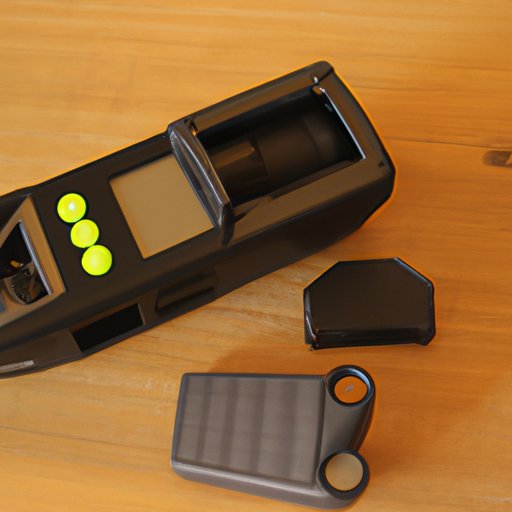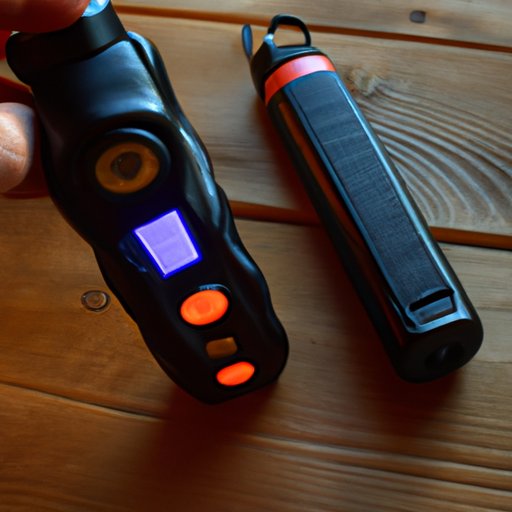Introduction
When it comes to self-defense, many people turn to tasers or stun guns as a non-lethal way to protect themselves. But how does a taser actually work? In this article, we’ll explore the science behind tasers, examining how they use electrical currents for self-defense. We’ll also look at the pros and cons of using a taser, as well as what you should know before buying one.

An Overview of How Tasers Work
A taser is an electroshock weapon that uses electrical currents to temporarily incapacitate a person. The electrical current is delivered through two small probes that are attached to the end of the taser, which can be fired from up to 15 feet away. The device works by disrupting the body’s normal communication pathways between the brain and the muscles, resulting in temporary paralysis.
The Science Behind the Taser: Exploring Electrical Currents for Self-Defense
Understanding electrical currents is key to understanding how a taser works. Electrical currents are made up of electrons, which carry a negative charge. When these electrons move, they create an electric field that can be used to disrupt the body’s normal communication pathways. This disruption is what causes the temporary paralysis that a taser produces.
The taser works by sending an electrical current through the two probes that are attached to it. The current passes through the body and disrupts the communication pathways between the brain and the muscles, resulting in temporary paralysis. This effect is similar to the one produced by a shock from an electric fence, but with a much lower voltage and amperage.
According to a study published in the journal International Emergency Nursing, “Tasers are designed to deliver a brief burst of electricity that is thought to override the body’s normal communication pathways, resulting in muscle contractions and temporary paralysis.” The study further notes that the effects of the taser are typically short-term and reversible.
The Pros and Cons of Using a Taser in Self-Defense
Using a taser in self-defense has both advantages and disadvantages. On the plus side, tasers provide a non-lethal way to protect yourself in dangerous situations. They are also relatively easy to use and can be fired from a distance, giving you time to escape if necessary.
On the other hand, there are potential risks associated with taser use. One of the biggest concerns is the risk of accidental injury or death. Taser shocks can cause serious injuries such as burns, broken bones, and even cardiac arrest. There is also the risk of misfiring the taser, which could result in the electrical shock being delivered to an unintended target.
What You Should Know Before Buying a Taser
Before buying a taser, it’s important to understand the laws and regulations surrounding their use. In some states, stun guns are illegal, so it’s important to check local regulations before making a purchase. It’s also important to note that some types of tasers require special permits or licenses to use.
In addition, it’s important to understand the different types of tasers available. Different models vary in size, power, range, and features, so it’s important to find one that meets your needs. Finally, it’s important to consider price and quality when making a purchase. Cheaper models may be less reliable and less powerful than more expensive models.

Taser Safety: Learning the Risks Involved with Stun Gun Use
Although tasers can be an effective form of self-defense, it’s important to understand the risks involved with their use. Potential injuries include burns, broken bones, and even cardiac arrest. Additionally, tasers can be misfired, resulting in the electrical shock being delivered to an unintended target.
To minimize the risks associated with taser use, it’s important to practice safe usage practices. This includes only using the taser in an emergency situation, and never aiming the taser at someone’s face or head. Additionally, it’s important to keep the taser out of the reach of children and to store it safely when not in use.
Conclusion
Tasers are an effective form of self-defense that use electrical currents to temporarily incapacitate a person. Understanding the science behind tasers is key to understanding how they work, and it’s important to consider both the advantages and disadvantages before using one. Additionally, it’s important to understand the laws and regulations surrounding taser use, as well as the potential risks involved with their use. By following these tips, you can ensure that you are using a taser safely and responsibly.
(Note: Is this article not meeting your expectations? Do you have knowledge or insights to share? Unlock new opportunities and expand your reach by joining our authors team. Click Registration to join us and share your expertise with our readers.)
